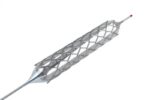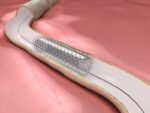Original title: Clinical Outcomes after Hybrid Coronary Revascularization versus Coronary Artery Bypass Surgery: A Meta-Analysis of 1,190 Patients. Reference: Ralf E. Harskamp et al. American Heart Journal (2014), epub ahead of print. Hybrid revascularization combines long-term patency of the mammary artery connected to the left anterior descending with minimally invasive drug-eluting stents to other injuries. This in<a href="https://solaci.org/en/2014/02/18/hybrid-revascularization-versus-conventional-surgery-advantages-and-disadvantages-for-choosing-ideal-patients/" title="Read more" >...</a>
Endovascular treatment in critical limb ischemia, better permeability with similar mortality and amputation than surgery.
Original title: Comparative effectiveness of endovascular and surgical revascularization for patients with peripheral artery disease and critical limb ischemia. Reference: W. Schuyler Jones et al. American Heart Journal 2014. Epub ahead of print. Critical limb ischemia is the most severe condition affecting patients with peripheral vascular disease. Mortality, morbidity, and costs associated with this condition are<a href="https://solaci.org/en/2014/02/14/endovascular-treatment-in-critical-limb-ischemia-better-permeability-with-similar-mortality-and-amputation-than-surgery/" title="Read more" >...</a>
Almost 40 % of those who initially receive clopidogrel then switch to prasugrel or ticagrelor in clinical practice.
Original title: In-hospital switching of oral P2Y12 inhibitor treatment in patients with acute coronary syndrome undergoing percutaneous coronary intervention: Prevalence, predictors and short-term outcome. Reference: Dimitrios Alexopoulos et al. Am Heart J 2014;167:68-76.e2. Given the availability of 3 Oral P2Y12 receptor inhibitors (clopidogrel, prasugrel, and ticagrelor) with different safety and efficacy profiles, the change from one to another<a href="https://solaci.org/en/2014/02/07/almost-40-of-those-who-initially-receive-clopidogrel-then-switch-to-prasugrel-or-ticagrelor-in-clinical-practice/" title="Read more" >...</a>
The ball drug is effective in the femoropopliteal area
Original title: Drug-Eluting Balloon in Peripheral Intervention for the Superficial Femoral Artery. The DEBATE-SFA Randomized Trial (Drug Eluting Balloon in Peripheral Intervention for Superficial Femoral Artery). Reference: Liistro, F, el tal. J Am Coll Cardiol Intv 2013;6(12):1295-1302 The current treatment of choice in the femoropopliteal area is angioplasty, however, this procedure has a high rate of restenosis<a href="https://solaci.org/en/2014/02/03/the-ball-drug-is-effective-in-the-femoropopliteal-area/" title="Read more" >...</a>
Decreased bleeding with radial access leaves little to bivalirudin for additional benefit
Original title: Bivalirudin or heparin in primary angioplasty performed through the transradial approach: results from a multicentre registry. Reference: Sciahbasi A et al. Eur Heart J: Acute Cardiovasc Care. Epub ahead of print. Bivalirudin benefit has been demonstrated in terms of bleeding; however when primary angioplasty is performed by radial access this information is not clear. To get<a href="https://solaci.org/en/2014/01/31/decreased-bleeding-with-radial-access-leaves-little-to-bivalirudin-for-additional-benefit/" title="Read more" >...</a>
The FFR changes the treatment strategy in almost half of patients
Original title: Outcome impact of coronary revascularization strategy reclassification with fractional flow reserve at time of diagnostic angiography. Reference: Van Belle E et al. Circulation. 2014 Jan 14;129(2):173-85. Any comprehensive registry has not been yet published that evaluates the impact of fractional coronary flow reserve (FFR) to change the strategy of revascularization on individual patients referred for diagnostic<a href="https://solaci.org/en/2014/01/29/the-ffr-changes-the-treatment-strategy-in-almost-half-of-patients/" title="Read more" >...</a>
Ischemic versus anatomical risk. Is anyone better to help us decide therapeutically?
Original title: Predicting Outcome in the COURAGE Trial. Coronary Anatomy Versus Ischemia. Reference: G. B. John Mancini et al. J Am Coll Cardiol Intv 2013, Article in press. Anatomical risk, ischemic amount or a combination of both, are often factors taken into account for estimating the prognosis or choose a treatment strategy. The COURAGE study (Clinical Outcomes Utilizing<a href="https://solaci.org/en/2014/01/24/ischemic-versus-anatomical-risk-is-anyone-better-to-help-us-decide-therapeutically/" title="Read more" >...</a>
Stent reestenosis, the only subgroup that benefits from longer double antiaggregation
Original title: Short vs. Long Term Duration of Dual Antiplatelet Therapy in Patients treated for InstentRestenosis. A PRODIGY Trial substudy. Reference: Gianluca Campo el al. J Am CollCardiol, article in press. In the study PRODIGY (Prolonging Dual Antiplatelet Treatment After Grading Stent- Induced Intimal Hyperplasia) we found that the 24 months ratio of dual antiaggregation was not<a href="https://solaci.org/en/2013/12/13/stent-reestenosis-the-only-subgroup-that-benefits-from-longer-double-antiaggregation/" title="Read more" >...</a>
Amputation, one of worse prognostic variables
Original title: Lower Extremity Amputation: Factors Associated With Mortality or Contralateral Amputation Reference: Samir K. Shah, et; al. Vascular and Endovascular Surgery 2013:47 (8):608-613. Peripheral vascular disease is associated with trophic injuries with tissue lose, often leading to amputation, of which about 50 % were major amputations. 454 amputations in 391 patients were analyzed, 63 were contralateral. Most<a href="https://solaci.org/en/2013/11/29/amputation-one-of-worse-prognostic-variables/" title="Read more" >...</a>
Culprit artery only versus revascularization with ST segment elevation myocardial infarction. The discussion continues
Original title: Complete Versus Culprit-Only Revascularization for Patients with Multi-Vessel Disease Undergoing Primary Percutaneous Coronary Intervention for ST-Segment Elevation Myocardial Infarction: A Systematic Review and Meta-analysis. Reference: Kevin R et al. American Heart Journal, article in press. Primary angioplasty is the preferred reperfusion strategy in patients experiencing a STEMI as it has proven superior to fibrinolysis in reducing<a href="https://solaci.org/en/2013/11/06/culprit-artery-only-versus-revascularization-with-st-segment-elevation-myocardial-infarction-the-discussion-continues/" title="Read more" >...</a>









